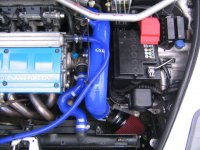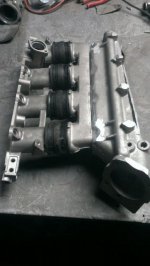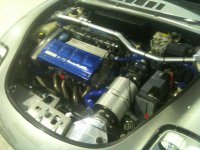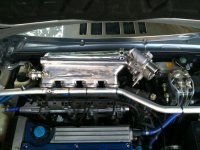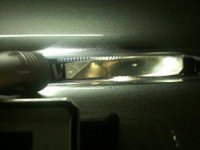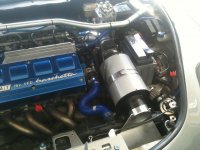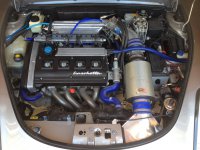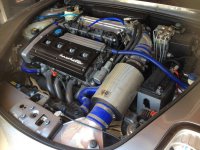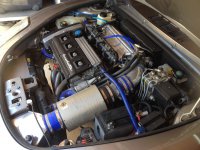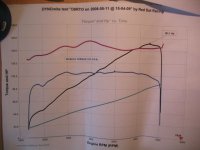Hiya guys,
NSMG, I received your message and so will endeavor to add my input.

My knowledge of a vehicles original induction may not be as that of s130's reply regarding a cars induction system and so any following information is that of my own trial and errors regarding my own B and its modifications to that of the design I have currently assigned to now.
One of my very first modifications was that of removing most of the original plastic components around the top area feeding the intake and also the removal of the large cylinder filter housing. Leaving only the black ridged flexy hose, connected to the air flow meter and then reconnected and replaced this with a High flow GREEN FILTER.
Now from my own experience this makes the B a little less restrictive and to sound a lot more sporty and so you seem to feel faster. I believe you gain a little more torque and horsepower at the higher rev range. +6-8bhp gain is quoted on their website.

Some trials on the position of the filter from low to high will certainly change the noise feature obtained although common sense tells me that lower down will en devour to pull in a cooler air and placement higher for which may increase the direct air flow may also pull in hotter air. From my knowledge cooler air is preferred for a better explosion of gases so that more power is gained. Hence when you drive in cool evening conditions your car performs better.
This is by far the cheapest way round for a little more gain around mid to high rev range.
As time went on and I fitted a full super sprint exhaust system and was introduced to the GSR INDUCTION HOSE.
This is a replacement silicone hose which replaces the black twisty bendy hose and has been specifically designed and tested on the Barchetta to which gains of 10-12 hp can be achieved when coupled with a high flow filter such as that mentioned above and a few other mods and tuning is also done. My own tests on a rolling road will confirm this.
I believe the extra gains are down to the smooth surface area of the hose compared to that of the original ridged and bendy hose .
Now I have installed and made a few other modifications to my B but at the time of fitting the free flow Exhaust system from SuperSprint.
Coupled with the Silicone GSR replacement induction hose and free flow filter
At tests on a rolling road my B showed 146bhp but was lacking fuel at high revs so I then replaced my fuel pump to a Maboro high pressure and regulator and further testing and gains increased to 151bhp.


See pictures.
In search of more power from the B I have since then went on to have had a complete one off redesign of the original intake manifold built . Which was designed and built in the UK from Dave (MR FIXIT Engine Tuning) I have not been back on a rolling road to test this although I can confirm much more power was felt at mid to high end. Its easy to take the MPH needle over



See pictures .
A fellow B owner in Italy who has now also had this redesign intake made by Dave who frequently races his B is always out in front of the others B owners which proves the new design works and increases power.



Over the years I have tinkered with my B and since gone a little further with my particular set up and design and made my own intake pipe and coupled with a sealed air filter and direct air scoop which is designed to have a ram air effect. At tests on a rolling road it was still around the 150bhp at this stage so seems to work and perform just as the GSR system.
My own personal reasons for this design is that my B is not an every day driver and usually is just taken out for a blast now and then. The ram effect does seem to have an effect at higher speeds and pushes air through the enclosed filter cooling it before entering the induction system.
See My KC3 Project Silver pg 62 onwards. for pics and design.
My current set up and induction is as the last pictures show although i have no performance charts to confirm it performance at present although my feelings are that I have gained a further 8-10 bhp from the new design intake manifold which should have me around the 160bhp or more mark.
Along with a new ported and flowed performance cylinder head I have now had built by Dave with higher lift cams which of yet has to be installed, my intention is to have a 170bhp+ naturaly aspirated Barchetta .
Hope my input has helped in any way.



